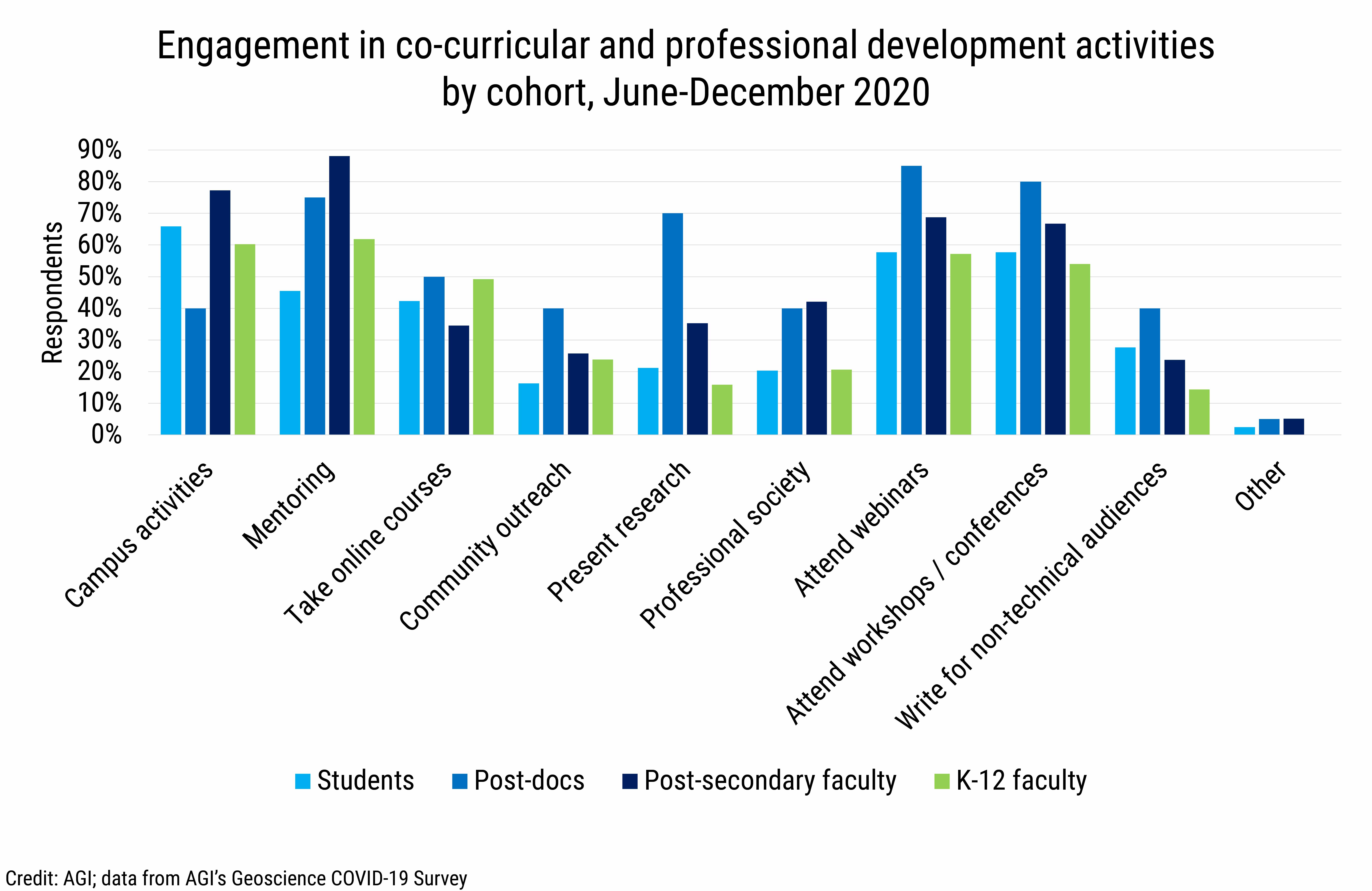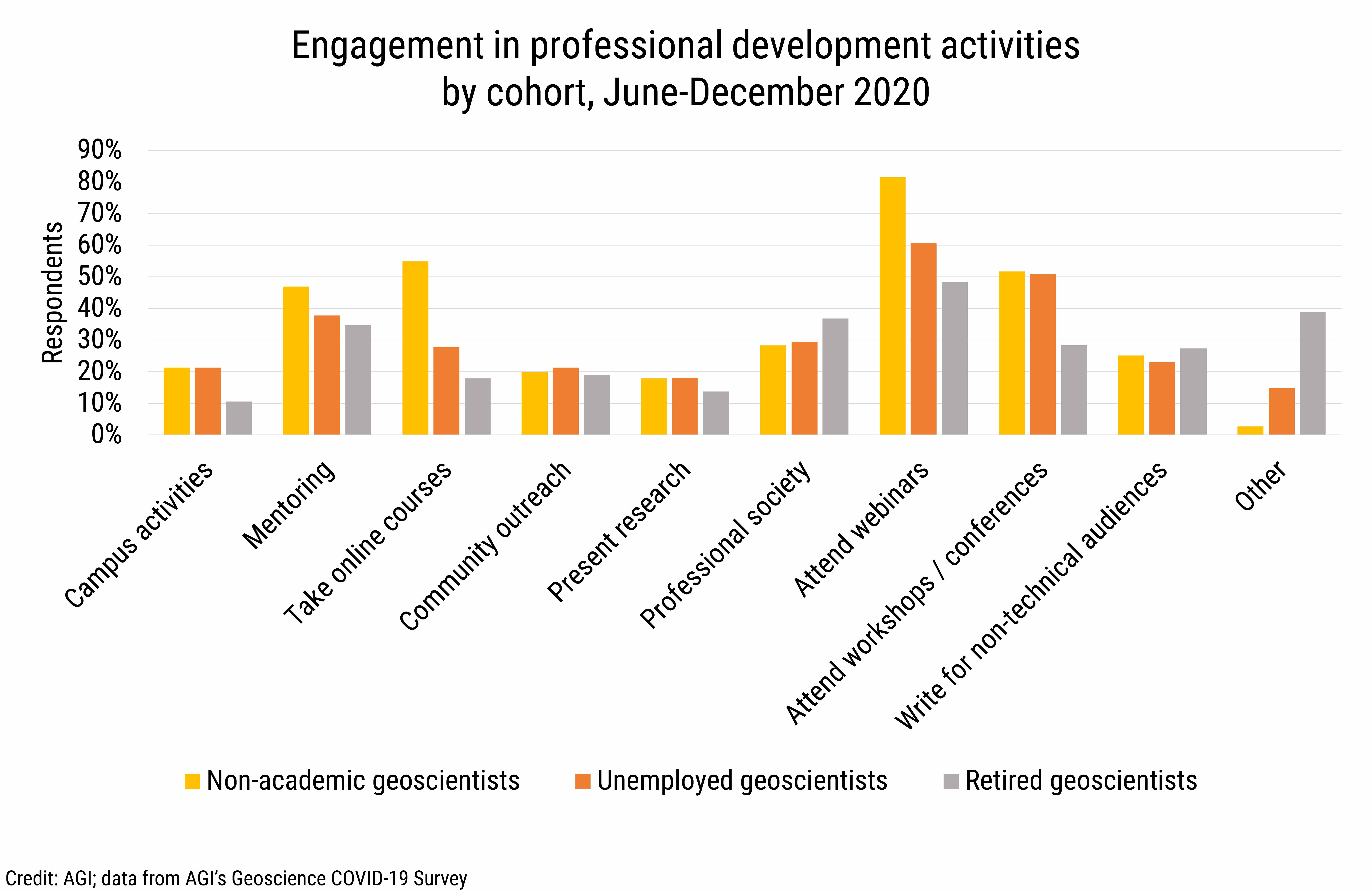Data Brief 2021-001 | January 8, 2021 | Written and compiled by Leila Gonzales and Christopher Keane, AGI, January 2021
Download Data Brief
Engagement in co-curricular and professional development activities during the pandemic
In this data brief, we examine how engagement in co-curricular and
professional development activities have varied during the pandemic.
Since June, attending webinars was the only activity that ranked in the
top three co-curricular and professional development activities across
all survey populations. The webinar and extra-curricular online course
topics reported to be taken include water and energy resource
management, environmental remediation, geology, hazards, online
teaching, career issues, ethics, diversity, equity and inclusion,
technology and applications, computer science (i.e., programming,
machine learning, etc.), business operations, and communication skills.
Courses and webinars were typically hosted by government agencies or
non-profit organizations.
Between June and December, the top three developmental activities
reported by students also included campus activities, such as
involvement in departmental committees, campus clubs, or student
government, and attending workshops or conferences. With the beginning
of the Fall term, student engagement in campus activities increased by
nearly 20% since July, peaking at 72% in October. Other increased
engagements included mentoring of other students and colleagues, with
48% of students reporting this activity in November. Other activities
with growth between June and December included community outreach and
presenting research at a conference, colloquium, or public event. The
percentage of students taking extra-curricular online courses declined
from 30% of students in June to 13% in December.

DB_2021-001 chart 01: Engagement in co-curricular and professional development activities by cohort, June-December 2020 (Credit: AGI; data from AGI's Geoscience COVID-19 Survey)
AGI
Post-secondary teachers reported engagement in campus activities, and
mentoring students and colleagues among their top three professional
development activities. The percentage of post-secondary faculty
mentoring students and colleagues increased to 87% in November, up from
67% in June. In addition, engagement in campus activities increased from
49% of post-secondary faculty reporting this activity in July to 79% in
October. During Fall, there were increases in the percentage of
post-secondary faculty attending workshops and conferences as well as
presenting research in these types of forums (as well as in departmental
colloquia and at public events). Declines in participation in webinars
and online classes occurred between June and December, with one-third of
post-secondary faculty reporting attending webinars in December, down
from 57% in June, and 11% of post-secondary faculty reporting taking
online classes in December, down from 25% in July.
K-12 faculty reported engagement in campus activities and mentoring
students and colleagues among their top three professional development
activities in addition to attending webinars. With the start of the Fall
term, there was a concurrent increase in the percentage of K-12 faculty
mentoring students and colleagues, with three-quarters of K-12 faculty
reporting this activity in December. The percentage of K-12 faculty
attending webinars peaked at 71% in October, up from 54% in June. The
percentage of K-12 faculty attending workshops and conferences peaked in
July and August (40% and 42%, respectively) and again in November and
December (50% and 58%, respectively). The percentage of K-12 faculty
attending online classes peaked in August at 54% and thereafter
declined to 17% in December.
In addition to webinars, the top three activities between June and
December reported by non-academic geoscientists included mentoring
colleagues and students, with third place split between attending online
classes (June through August) and attending workshops and conferences
(September through December). The percentage of non-academic
geoscientists actively volunteering for professional societies
increased to 28% in November, up from 18% in June. The percentage of
non-academic geoscientists engaged in mentoring colleagues and students
also peaked in November at 46%, up from 29% in June. Activities where
there were declines in participation included online classes (from 43%
in July to 26% in December) and webinar attendance (74% in July to 66%
in December).

DB_2021-001 chart 02: Engagement in professional development activities by cohort, June-December 2020 (Credit: AGI; data from AGI's Geoscience COVID-19 Survey)
AGI
Retired geoscientists also reported mentoring colleagues and students
and actively volunteering for professional societies among their top
three professional development activities. Active volunteering for
professional societies increased from 18% of retirees in July to 41% in
December. Participation in webinars also increased over this period.
Participation in other activities peaked in July through September
(29%, 45%, and 33% over the three months respectively), with most
retirees engaging in research projects and editing or reviewing journal
articles during this time.
Unemployed geoscientists reported mentoring colleagues and students and
attending workshops and conferences in addition to attending webinars as
their top three professional development activities. The percentage of
unemployed geoscientists taking online classes and attending webinars
increased between June and December, 29% to 50% and 50% to 63%,
respectively. In addition, the percentage of unemployed geoscientists
actively volunteering for professional societies also increased, from
21% in June to 50% in December. Also, the percentage of unemployed
geoscientists writing for non-technical audiences increased in the last
quarter of 2020, from 14% to 25%. Participation in workshops and
conferences peaked in June and July (50% and 42% respectively) as well
as in October and November (45% and 41% respectively).
We will continue to provide current snapshots on the impacts of COVID-19
on the geoscience enterprise throughout the year. For more information,
and to participate in the study, please visit:
www.americangeosciences.org/workforce/covid19